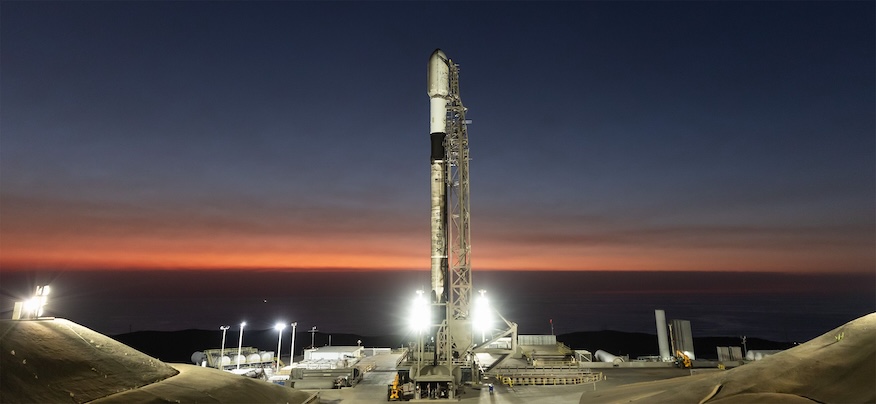SpaceX continues to push the boundaries of space technology with its latest launch, sending 24 Starlink V2 Mini satellites into a polar orbit. This mission, executed via a Falcon 9 rocket from Vandenberg Space Force Base in California, highlights SpaceX’s commitment to expanding its Starlink network and improving global internet connectivity, particularly in underserved polar regions. This launch not only adds to the growing constellation of Starlink satellites but also demonstrates the company’s reusability capabilities with its Falcon 9 booster.
The successful deployment of these satellites is crucial for enhancing internet speeds and reliability in areas like Alaska, where connectivity has been historically limited. By strategically positioning these satellites in polar orbits, SpaceX aims to bridge the digital divide and provide high-speed internet access to remote communities. This article will delve into the details of the launch, the significance of polar orbits for satellite internet, and the future implications of SpaceX’s ambitious Starlink project.
Launch Details and Timing
The Starlink 17-3 mission lifted off from Space Launch Complex 4 East at Vandenberg Space Force Base in California at 8:52 p.m. PDT (11:52 p.m. EDT / 0352 UTC). The launch window was strategically chosen to deploy the satellites into a polar orbit shortly after sunset. Spaceflight Now provided live coverage of the event, ensuring enthusiasts and stakeholders could witness the launch in real-time. According to expert orbital tracker Jonathan McDowell, this mission adds another 24 satellites to SpaceX’s megaconstellation, which already consists of more than 7,900 satellites.
SpaceX’s ability to execute launches with such precision and frequency is a testament to its advanced engineering and operational capabilities. The company’s focus on reusability, as demonstrated by the Falcon 9 booster, significantly reduces the cost of space missions, making projects like Starlink more economically viable. This latest launch underscores SpaceX’s role as a leader in the commercial space industry, driving innovation and expanding access to space for various applications.
Falcon 9 Booster B1082’s 14th Flight
The Falcon 9 first stage booster, tail number B1082, was used for the 14th time on this mission. Its previous missions include NROL-145, USSF-62, and OneWeb #20. This remarkable feat of reusability highlights SpaceX’s commitment to reducing the cost of space travel. A little more than eight minutes after liftoff, B1082 successfully landed on the droneship ‘Of Course I Still Love You,’ marking the 141st booster landing on this vessel and the 477th booster landing to date.
SpaceX’s reusability program is a cornerstone of its business model, allowing the company to offer competitive pricing for its launch services. By recovering and reusing its Falcon 9 boosters, SpaceX significantly lowers the cost per launch, making space missions more accessible to a wider range of customers. This approach not only benefits SpaceX financially but also contributes to the sustainability of space exploration by reducing waste and promoting efficiency.
Starlink’s Expansion into Polar Orbit
SpaceX plans to deploy hundreds of satellites into a polar orbit to improve connectivity in polar regions, like Alaska. In an update posted to its Starlink website, SpaceX stated its intention to launch more than 400 additional satellites to the polar inclination by the end of 2025. This initiative is expected to more than double the capacity for Alaskan customers alone, as well as other high latitude locations. The company noted that the first of these additional satellites have already begun to serve Alaskan users, nearly doubling median peak-hour download speeds over the past month.
The decision to focus on polar orbits is a strategic move by SpaceX to address the unique challenges of providing internet connectivity to high-latitude regions. Polar orbits allow satellites to pass over the Earth’s poles, providing coverage to areas that are often difficult to reach with traditional geostationary satellites. By expanding its constellation in this manner, SpaceX is demonstrating its commitment to serving underserved communities and bridging the digital divide.
Future Launches and NASA’s TRACERS Mission
Following the Friday night flight, SpaceX will turn its attention to a rideshare mission for NASA, which is highlighted by the agency’s TRACERS (Tandem Reconnection and Cusp Electrodynamics Reconnaissance Satellites) payload. This mission underscores the collaborative relationship between SpaceX and NASA, with SpaceX providing launch services for critical scientific missions. NASA’s TRACERS mission aims to study magnetic explosions in space, providing valuable insights into the interaction between the Sun’s magnetic field and Earth’s magnetosphere.
SpaceX’s ability to support both commercial and scientific missions highlights its versatility and reliability as a launch provider. The company’s partnership with NASA is crucial for advancing space exploration and scientific discovery, with SpaceX playing a key role in facilitating access to space for a wide range of research and development activities. This collaboration not only benefits both organizations but also contributes to the broader advancement of space technology and knowledge.
Conclusion
SpaceX’s successful launch of 24 Starlink satellites into polar orbit marks another milestone in the company’s mission to provide global internet connectivity. By leveraging its reusable Falcon 9 rocket and strategically deploying satellites in polar orbits, SpaceX is addressing the unique challenges of serving high-latitude regions. This launch not only enhances internet speeds and reliability in areas like Alaska but also demonstrates SpaceX’s commitment to innovation and sustainability in the space industry.
As SpaceX continues to expand its Starlink constellation and collaborate with organizations like NASA, the company is poised to play a pivotal role in shaping the future of space exploration and communication. The ongoing development of reusable rocket technology and the strategic deployment of satellites in various orbits will undoubtedly lead to further advancements in space-based services, benefiting communities around the world and driving the next era of space innovation.

Leave a Reply